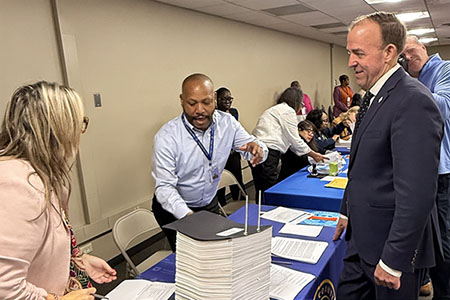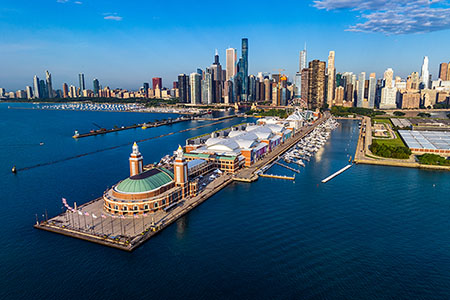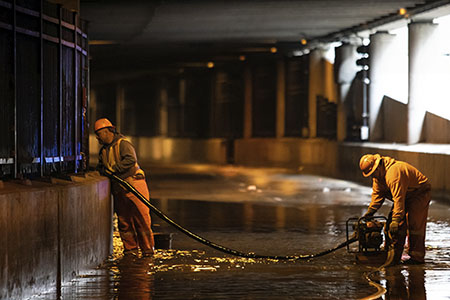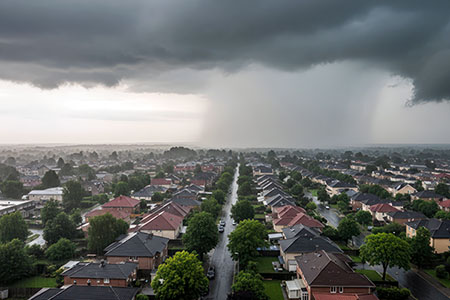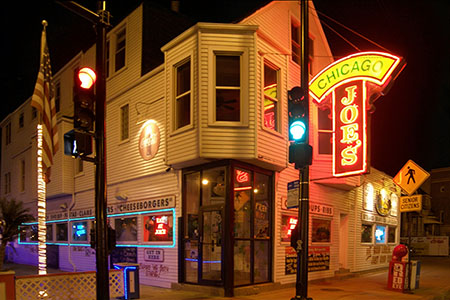
As recent monsoon-like rains inundate neighborhoods, Chicago homeowners are grappling with rampant basement flooding.
(Above) 2017 photo of a flooded Chicago Riverwalk. Aug. 25, 2025 – Is Chicago the “Windy City” or the “Water City?” That’s the question homeowners are asking as they complain about their recent basement flooding after recent monsoon weather events. With climate change causing record summer rains of up to seven inches in Chicago and suburbs, and flooded basements becoming the norm in many neighborhoods, there’s water, water everywhere, and the City of Chicago has left homeowners bailing their boats.
Chicago’s Department of Water Management Commissioner Randy Conner called the recent tsunami-like deluge – nearly six inches in under two hours – a “100-year downpour.” Connor said the emergency management office is asking residents impacted by the storms to fill out a floor damage assessment survey, which he says will help homeowners pursue options for additional resources. City officials floated quicker solutions – adding sensors in drains, planting thousands of trees, and more aggressively clearing street sewer pipes. 15th Ward Alderman Raymond Lopez criticized the mayor for pushing for more city revenue to solve the flooding problems and heavily blamed the city’s 100-year-old sewer lines. Lopez and five other South and Southwest side Aldermen sent Mayor Johnson a letter last week asking him to establish a rebate for homeowners who install flood-preventing backflow valves, which could cost as much as $50 million citywide. Lopez wants the mayor to spend city money now to help residents clean up their rain-soaked basements, in anticipation of federal disaster funds that could take years to come from President Donald Trump, or may never arrive. In 2011, Mayor Rahm Emanuel convinced the City Council to raise water and sewer rates by $120 a year for the average homeowner by doubling those rates over four years and locking in annual cost-of-living increases after that. The Emanual plan was to replace all 900 miles of the city’s century-old water pipes and reline or replace 750 miles of 100-year-old sewer lines. Unfortunately, that never happened.
“Of course, you’d have to re-establish a relationship with the federal government to help you out with that. The city obviously doesn’t have any money at the moment,” said Guidice. The North Side’s Albany Park neighborhood had chronic flooding problems until a $70 million underground pipeline was built. The one-mile tunnel is located 150 feet below Foster Avenue and runs east from Eugene Field Park to the North Shore Channel. During heavy rains, the Albany Park pipeline moves excess water from the north branch of the Chicago River into the North Shore Channel, a drainage canal that runs from Lake Michigan near Wilmette to the Chicago River. Since that was done, Albany Park has not had a flooding problem. Homeowner flood survival kit So, decades later, and after dozens of basement floods, what is a homeowner to do? The Home Front has assembled the following flood survival kit to help homeowners overcome the water in their basements: • Before the flood hits, hire a professional home inspector to tour the interior of your basement. Ask the inspector to write a report on suggestions for water penetration prevention. • Review your home’s gutter and downspout direction. Make sure your downspouts empty far away from your home. Do not let downspouts empty into your catch basin, which usually is near the house. This is especially true if your home was built after 1960. Downspouts should be extended at least 10 feet away from your foundation and empty on a section of your lawn. Also check your neighbor’s downspouts to make sure they are not emptying close to your foundation. • Owners of older Chicago homes often have standpipes installed in original basement floor drains. Standpipes usually are about four-feet tall, and pretty ugly, but they may prevent floor drain water from overflowing into the basement if the city sewer line is overwhelmed in a downpour.
• Buy sewer backup insurance, which adds about $200 a year to the standard home insurance policy premium. • Sump pump inspection. Make sure your sump pump is working or install a new one with a battery backup for a cost of about $200. • Foundation cracks. Search for any cracks in your foundation and hire a professional foundation repair contractor to make hydraulic cement repairs. The cost is $750 to $1,500. • Install a power check valve between the main city sanitary sewer pipe and your house. Estimated cost is $6,000 to $16,000. A check valve prevents city sewer water from backing up through the city sewer line into the basement floor drains inside your house but allows home sewer water to drain out. • Install interior drain tiles around the perimeter of your basement walls. This is a costly project that can run $15,000 to $20,000 or more.
In 2024, the homeowner paid a whopping $23,029 for the complete waterproofing package, which is under warranty. Unfortunately, her basement flooded again a couple of weeks ago, causing an estimated $17,000 in damage. She filed an insurance claim because the home is protected by sewer backup insurance. The homeowner is waiting for a warranty response from the waterproofing company. A courtesy inspection is scheduled for next week. |










